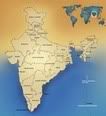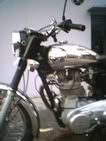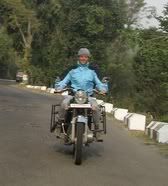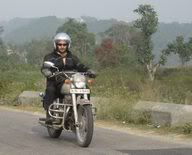How to Buy a Used Enfield
This website is aimed at helping you to buy and tour around on a
used or second hand Royal Enfield motorcycle in India.


-At a Glance...-Which Motorcycle to Buy-|-Which Enfield Model
-How Much to Spend-|-Tips On Buying a Used Motorcycle-|-Legal Stuff
-Border Crossings-|-Maintenance & Statistics-| -Which Mechanic
-Buying in Deli-|-Labour Prices-|-Petrol Consumption-|-Touring Info
-Speed & Roads-|-Stuff to Carry-|-General Tips-|-Transportation on Train
-Links-|-Videos-|-Comments-Questions-|-The Author-...At a Glance
| By Jean-Paul |

"Not all who wander are lost.." - J.R. Tolkien Updated - Jan 2010 Created - Dec 2008 |
|---|
| [Videos] |
- Bike River Crossing 2007 Weekend Away 2008 - Part 1 - Part 2 - Who Checked the --Weather? 2008 |
| [Contibutors] |
Thanks to the following... Tom Brabers Jim Collins Murdy Murdooch Paul Read Phillipa Saxton |
| [My Guestbook] |
|
| [Links] |
Different Opinions - from royalenfields.com Horizons Unlimited - Motorcycle Touring How 2 buy Used Enfield Travelling India On A Royal Enfield Wiki How -Buying Used Enfield |
| [Counter] |
|
|
Advice on How to Buy a Used Royal Enfield Motorbike  Tips on How to Buy a Second Hand Royal Enfield Motorcycle  How to Buy Royal Enfield Motorbike  How to Buy Royal Enfield  Advice to Buy a Second Hand Royal Enfield Motorcycle  Touring on a Royal Enfield Motor in India  Tips to Buy a Second Hand Royal Enfield Motorbike  Help to Buy a Used Royal Enfield Motorbike  For Sale Royal Enfield Motorcycle  Advice to Buy a Used Royal Enfield Motorcycle  Help on Buying a Second Hand Royal Enfield Motorbike  Advice Buying a Used Royal Enfield Motorbike  Touring on a Royal Enfield Motorcycle in India  Tips Buying a Used Royal Enfield Motorcycle  For Sale Royal Enfield Motorbike  Help on Buying a Used Royal Enfield Motorbike  Touring on a Royal Enfield in India  Advice on Buying a Second Hand Royal Enfield Motorbike  Tips to Buy a Second Hand Royal Enfield Motorbike  Help Buying Second Hand Royal Enfield Motorbike  Want to Buy a Royal Enfield Motorcycle  Advice on Second Hand Royal Enfield Motorbike  Want to Buy a Royal Enfield Motorcycle  Want to Buy a Royal Enfield Motorbike  Tips Help Advice Royal Enfield in India  Sell Royal Enfield Motorbike  Royal Enfield Bullet For Sale  Help on How to Buy a Used Royal Enfield Motorcycle |
Maintenance, Servicing and Running Costs Statistics
In my experience I have always found that the genuine Royal Enfield Workshops to be the best. They dont over charge on labour or parts, and the mechanics are relaxed and competent. Many of the Enfield Wallahs are cow boys swinging hammers...people you just dont want to come with in throwing distance of your baby..
Although it is India and you should stay present and ensure they do the work properly and not cheat on you. (that is, not replace a part they may charge you for). Often the head mechanic (who knows what he is doing) orders one of his juniors to do the work. Sometimes I catch these guys doing things that are just bloody stupid.
For instance- The gear box oil had to be drained so that the kick start spring could be replaced. They placed the oil collecting dish under the center stand and then let the gear box oil drain. So all my oil was washing onto the dirt of my center stand and then into dish. Unlike the west, this same oil goes back into the bike... I quickly got them to stop!
When touring keep an eye out on your nuts and bolts. Regularly check them to ensure they are tight; some work loose on the shitty roads. Where possible, get the mechanics to replace the nuts with lock tight nuts or even a basic spring washer. I have seen 2 people on the road lose the exhaust pipe because Enfield doesnt issue them with lock nuts.
The rear wheel spokes also tend to break when riding 2-up with luggage. If more than 2 break on the same side of the wheel they will need replacing otherwise you run the risk of the wheel severely buckling. Any tyre repair man (Tyre Wallah) can replace them but you will have to have your own spare spokes.
Also keep a regular check on your engine oil, clutch and gearbox oil levels. Remember the engine needs to be cold to get a proper oil level reading for all 3. Surprisingly my Enfield uses next to no engine oil but there must be a slow leak in the gearbox casing as I have to regularly top up the gearbox oil.
Your rear chain needs to be regularly oiled. The rollers on the chain should always look a little grey to black, which indicates there is oil on it (see pic). If it is shiny, it may look great but your chain will wear out quickly. The bike starts to lose alot of horse power to the rear wheel if the chain becomes worn. Plus the added risk of the chain snapping.
Manual recommends 25 to 30mm chain slackness, which is measured on the bottom chain in the center of the two sprockets. You will have to rotate the chain around one full revolution and find the tight spot. As chains get old, a side of the chain will be loose and the another side will be tight. You Will need to measure the free play from the tight spot.
Be careful with some mechanics as they over tighten the chain which causes more harm to it. This 25 to 30mm play is measured when the bike is normally loaded. So if you are riding 2 up, check the chain tension by having 2 people sit on the bike for you. Also allow a little extra slackness for your luggage.
For example, one person sitting on my bike tightens the chain by 5mm. So when I set the chain, if the free play on the center stand is 25mm then it is to tight, because when I sit on the bike the free play will reduce to 20mm. Thus I loosen the chain by one notch. Better a little loose than too tight.
After setting the chain you will have to check your rear brake, because tightening the chain will tighten your rear brake. Make sure your rear brake is not locked on like a hand brake due to the adjustment of the chain. When I was new to the Enfield (September 2007) I had the chain tightened by a teenage mechanic. I rode quite a few kms before I noticed that the bike was running slow, and when I stopped the rear brake was smoking...
Enfield Mechanics recommend oil changes at 3000Km. I find this too quick, as the oil is still in good quality, its expensive to replace and unhealthy for the environment. My manual recommends 6000km. These days I aim for about 4500Km oil changes. I would recommend changing the gear box oil once every year.
Labour is cheap in India, about 150-200Rs for 2-3 hours work. The oil, like petrol, is expensive.
The Enfield manual recommends the following minimum tyre treads-
Front = 1mm
Rear = 2mm
However I changed my rear tyre (MRF Nylo Grip Plus) after it had done 25154Km and it had just 1mm depth of tread left, but I could have ridden a little longer on the same tyre without problems. I recommend changing the front tyre before the tread wears down to 1mm or less, as a slipping front wheel often results in bangs, bruises and deflated egos etc :) See also Tyres and Suspension in the Touring Info section for information about tyre pressure and tyre combinations.
A Service, with no parts to be replaced will approximately cost (based on 2009)
-Labour 150Rs
-Engine oil (2.5 litres) 560 Rs [for Castrol GTX oil]
-Oil Filter 30 Rs
**Total 740Rs (add 80Rs for 1/2 litre gear box oil)
Common Spare Parts Pricing (based on 2009)
-to fix a puncture at a tyre wallah, around 30-40Rs
-Air Filter (paper type) 150Rs
-Battery from 600Rs to 1000Rs
-Cable clutch 120Rs
* Clutch cables tended to break after 10 000Km
-Cable throttle 80Rs
-Chain link 20Rs
-Chain (o-ring) with front & back sprockets 1100Rs
-Clutch plates 275Rs
-Clutch seal 75Rs
-Clutch springs 42Rs
-Drum brake pads 130Rs
-Front fork seal 22rs (need 2 per fork)
-Front fork oil 90rs (for both forks)
-Gearbox gasket 10Rs
-Head lamp 20RS
-Head gasket 80Rs
-Horn Bracket 30Rs
-Kick start spring 15Rs
-L-shape carby hose 40Rs
-Petrol Cap 120Rs
-Rear wheel spokes 6Rs each
-Rear wheel bearing 90Rs
-Rear wheel tube 220Rs
-Rear wheel tyre 1600Rs (MRF Nylo Grip Plus, size 3.50.19)
-Spark Plug 55Rs
-Valve oil seals 100Rs
Running Cost Statistics
My 2006 Enfield Machismo 350cc
(8 months old, 6510km on the guage)
I had my Enfield Machismo from August 2007 (6510km on the Tachometer) to November 2009, a total of 650 days in India, and I have toured 18 783Kms on it.
In that period I have spent a total of 19476Rs in maintenance/repair costs (excluding petrol). That works out to be-
1.04Rs per Km or 30.0Rs per day it costs to maintain the motorbike.
However in that period I been 45 times to see someone for the bike (or do essential repairs myself, such as a new clutch cable); such as a mechanic, a welder for the luggage rack, seat repairs etc.
This means I have had the bike looked at (mostly a mechanic) once every 417Km or once every 2 weeks (14.4 days). As I have said before, Enfields are not reliable, and this was an 8-month-old bike when I bought it; a mechanics dream....
As I maintained the bike well I managed to sell it for about the same price I bought it. Thus in terms of buying and selling the bike it didnt cost any extra Rupees. But if I consider the exchange rate movements of Euro to Rs in the last 2.5 years then I lost a little on the resale of the bike in terms of actual Euros spent. (ie- the bike costed more in Euros to buy than what I sold it for in Euros)
A 1996 Enfield Bullet 350cc provided by Paul Read
Bike was bought in October 2008 for 25000Rs and was sold again in February 2009 for 12500Rs. During the 75days of ownership it was ridden 6735Km.
During that period a total of 12 756Rs was spent on the bike (excluding petrol), meaning the bike sold for less than what was spent on repairs.
Thus-
1.89Rs per Km or 170Rs per day it costed to maintain the motorbike. If we include money lost on resale (the motorbike was sold for less than half of the purchase price); this works out to be 3.75Rs per Km or 337Rs per day it costed to use the motorcycle.
In that period the bike had been brought 15 times to someone for repairs. This means the bike has been looked at once every 449Km or once every 5.0days. (and the bike had alot of major work done in that period, see log book for details)
To read Pauls personal overview of riding a Bullet, with a detailed cost break down, follow this link.>>Top

